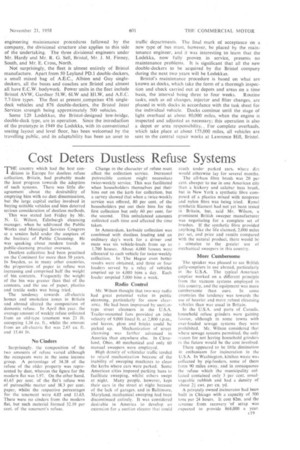Cost Deters Dustless Refuse Systems
Page 57

If you've noticed an error in this article please click here to report it so we can fix it.
THE country which had the best conditions in .Europe for dustless refuse collection, Britain, had probably made the least progress towards the adoption of such systems. There was little disagreement . about the desirability of emptying bins with no dust dissemination, but the large capital outlay involved in buying Suitable vehicles and bins deterred serious consideration of dustless methods.
This was stated last Friday by Mr. N. G. Wilson, Edinburgh cleansing manager, when he addressed the Public Works and Municipal Services Congress at a session held under the auspices of the Institute of Public Cleansing. He was speaking about modern trends in public-cleansing practice overseas.
Dustless collection had been practised on the Continent for more than 50 years. In Sweden, as in many other countries, the proportion of paper in refuse was increasing and comprised half the weight of bin contents. Frequently the weight of the bin was greater than that of the contents, and the use of paper, plastics and textile sacks was being tried.
The tendency towards all-electric homes and smokeless zones in Britain and abroad altered the composition of domestic refuse. In April this year, the average amount of weekly refuse collected from an old-type tenement was 21 lb. occupying 1.34 Cu. ft„ whilst the amount from an all-electi ic flat was 2.65 Cu. ft. and 15.44 lb.
No Cinders Surprisingly, the composition of the two amounts of refuse varied although the occupants were in the same income group. A percentage of 34.38 of the refuse of the older property was represented by dust, whereas the figure for the modern fiat was 1.97. On the other hand, 41.65 per cent. of the fiat's refuse was of putrescible matter and 38.3 per cent. paper, whilst the respective percentages for the tenement were 4.03 and 11.63. There were no cinders from the modern flat, but such material formed 32.19 per cent. of the tenement's refuse. Change in the character of refuse must affect the collection service. Increased putrescible content might necessitate twice-weekly service. This was facilitated when householders themselves put their bins out on the kerb for collection, but a survey showed that when a. twice-weekly service was offered, 80 per cent, of the householders put out their bins for the first collection but only 60 per cent. for
the second, This unbalanced amounts collected each time and affected the time taken.
In Amsterdam, kerbside collection was combined with dustless, loading and an ordinary day's work for a driver and mate was six vehicle-loads from up to 1,700 houses. About 4,000 houses were allocated to each vehicle for twice-weekly collection. In The Hague even better results were obtained, and three or four loaders served by a relay of vehicles emptied up to 4.000 bins a day. Each loader emptied 5,000 bins a week.
Radio Control Mr. Wilson thought that two-way radio had great potential value in public cleansing, particularly for snow clearance. He had been impressed by suctiantype street cleansers in the U.S.A. Trailer-mounted fans provided an inlet velocity of 9,000 lineal ft. at 2,800 r.p.m., and leaves, glass and bricks could be
picked up. Mechanization of street cleansing was farther advanced in America than anywhere else. In Cleveland, Ohio, 40 mechanical and only 60 manual sweepers were employed.
High density of vehicular traffic tended to retard mechanization because of the inability of sWeeping machines to clean the kerbs where cars were parked. Some American cities imposed parking bans to facilitate sweeping, whilst others swept at night. Many people, however, kept their cars in the street at night because of the lack of garages, and in Baltimore, Maryland, mechanical sweeping had been discontinued entirely. It was considered desirable in America to develop an extension for a suction cleaner that could
reach under parked ears, where dirt would otherwise lay for several months.
The all-bass fibre brush was 20 per cent. cheaper to use in one American city than a hickory and calabar bass brush, but in New York a synthetic fibre composed of a plastics mixed with neoprene and nylon fibre was being tried. Rynal synthetic filament had not yet been tested in Britain, but, said Mr. Wilson, a prominent British sweeper manufacturer was negotiating for a complete set of brushes. lf the synthetic fibre provided anything like the life claimed, 2,000 miles per set, and price and results compared with the natural product, there would be a stimulus to the greater use of mechanical sweepers in this country.
More Cumbersome The speaker was pleased to see British gully-emptiers in use abroad, particularly in the U.S.A. The typical American emptier worked on a different principle from the vacuum systems employed in this country, and the equipment was more cumbersome than ours. In some countries the tendency was towards the use of heavier and more robust cleansing vehicles than was usual in Britain.
In the U.S.A. and parts of Canada, household refuse grinders were gaining favour, although in some towns with over-loaded sewage systems they were Prohibited, Mr. Wilson considered that where sewage systems permitted, the only reason for not having household grinders in the future would be the cost involved, fhere appeared to be little diminution in enthusiasm for incineration in the U.S.A. In Washington, kitchen waste was collected by pig-feeders, some of them from 90 miles away, and in consequence the refuse which the municipality collected contained only 3 per cent, unsalvageable rubbish and had a density of about 21 cwt. per cu. yd.
A privately owned incinerator had been built in Chicago with a capacity of 500 tons per 24 hours. It cost $2m, and the revenue from recovery of scrap was expected to provide $68,000 a year.












































































































